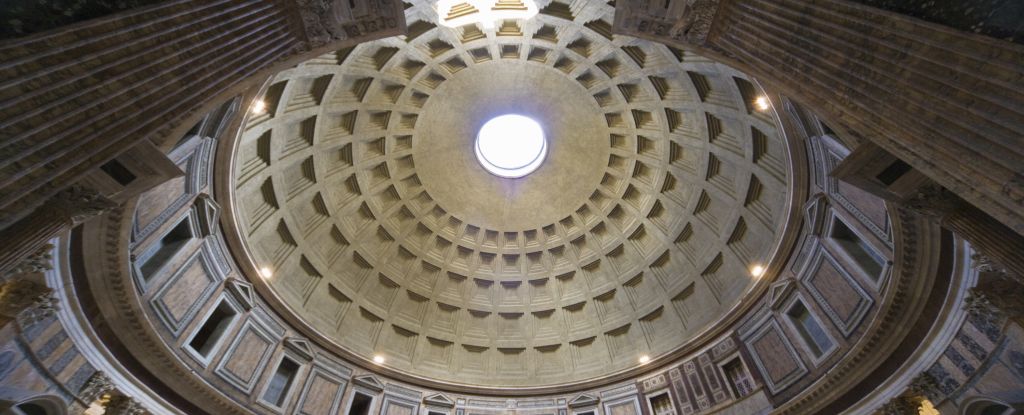The ancient Romans were master builders and engineers, perhaps best known for the working aqueducts. And these architectural marvels are based on a unique building material: pozzolanic concrete, a spectacularly durable material that gave Roman structures their incredible strength.
Even today, one of their structures – the still intact and almost 2,000-year-old Pantheon – holds the record for the world’s largest dome made of unreinforced concrete.
The properties of this concrete are generally attributed to its constituents: pozzolana, a mixture of volcanic ash – named after the Italian town of Pozzuoli, where a significant deposit of it is found – and lime. When mixed with water, the two materials can react to form strong concrete.
But that, as it turns out, isn’t the whole story. An international team of researchers led by the Massachusetts Institute of Technology (MIT) found that not only are the materials slightly different from what we might have assumed, but also the techniques used to mix them.
The smoking guns were small, white chunks of lime found in what appeared to be well-mixed concrete. The presence of these chunks has previously been attributed to bad mixing or materials, but that made no sense to MIT materials scientist Admir Masic.
“The thought that the presence of these calcareous clasts is simply due to poor quality control has always bothered me.” Masic said in a January 2023 statement.
“If the Romans put so much effort into producing an excellent building material, following all the detailed recipes tweaked over the course of many centuries, why should they put so little effort into ensuring the production of a well-mixed end product? “There must be more to this story.”
Masic and the team, led by MIT civil engineer Linda Seymour, carefully examined 2,000-year-old samples of Roman concrete from the Privernum archaeological site in Italy. These samples were subjected to large area scanning electron microscopy and energy dispersive X-ray spectroscopy, powder X-ray diffraction and confocal Raman imaging to gain a better understanding of the calcified clasts.
One of the questions that came to mind was the type of lime used. The standard understanding of pozzolanic concrete is that it is used slaked lime. First, limestone is heated at high temperatures to create a highly reactive caustic powder quicklimeor calcium oxide.
Mixing quicklime with water creates slaked lime, or calcium hydroxide: a slightly less reactive, less caustic paste. According to the theory, it was this slaked lime that the ancient Romans mixed with the pozzolana.
Based on the team’s analysis, the calcareous clasts in their samples do not agree with this method. Rather, Roman concrete was likely made by directly mixing the quicklime with pozzolana and water at extremely high temperatures, alone or in addition to slaked lime, a process the team calls “hot mixing” that results in the formation of lumps of lime.
“Hot mixing has two advantages” said Masic.
“First, heating all of the concrete to high temperatures enables chemical processes that would not be possible using slaked lime alone, creating high temperature compounds that would not otherwise form. Second, this increased temperature significantly reduces curing and setting times, as all reactions are accelerated, allowing for much faster construction.”
And it has another advantage: the lime sludge gives the concrete remarkable self-healing powers.
When cracks form in the concrete, they tend to migrate to the lime clasts, which have a larger surface area than other particles in the matrix. When water enters the crack, it reacts with the lime to form a calcium-rich solution that dries and hardens into calcium carbonate, sealing the crack back together and preventing further propagation.
The was observed made of concrete from another 2,000-year-old site, the tomb of Caecilia Metella, where cracks in the concrete were filled with calcite. This could also explain why Roman concrete from dykes built 2,000 years ago has survived intact for millennia despite the constant destruction of the ocean.
So the team tested their findings by making pozzolana concrete using ancient and modern recipes using quicklime. They also produced a control concrete without quicklime and carried out crack tests. In fact, the cracked quicklime concrete healed completely within two weeks, but the control concrete remained cracked.
The team is currently working on commercializing their concrete as a greener alternative to current concretes.
“It’s exciting to think about how these more durable concrete formulations could not only extend the life of these materials, but also how they could improve the durability of 3D printed concrete formulations.” said Masic.
The research was published in scientific advances.
A version of this article was first published in January 2023.





